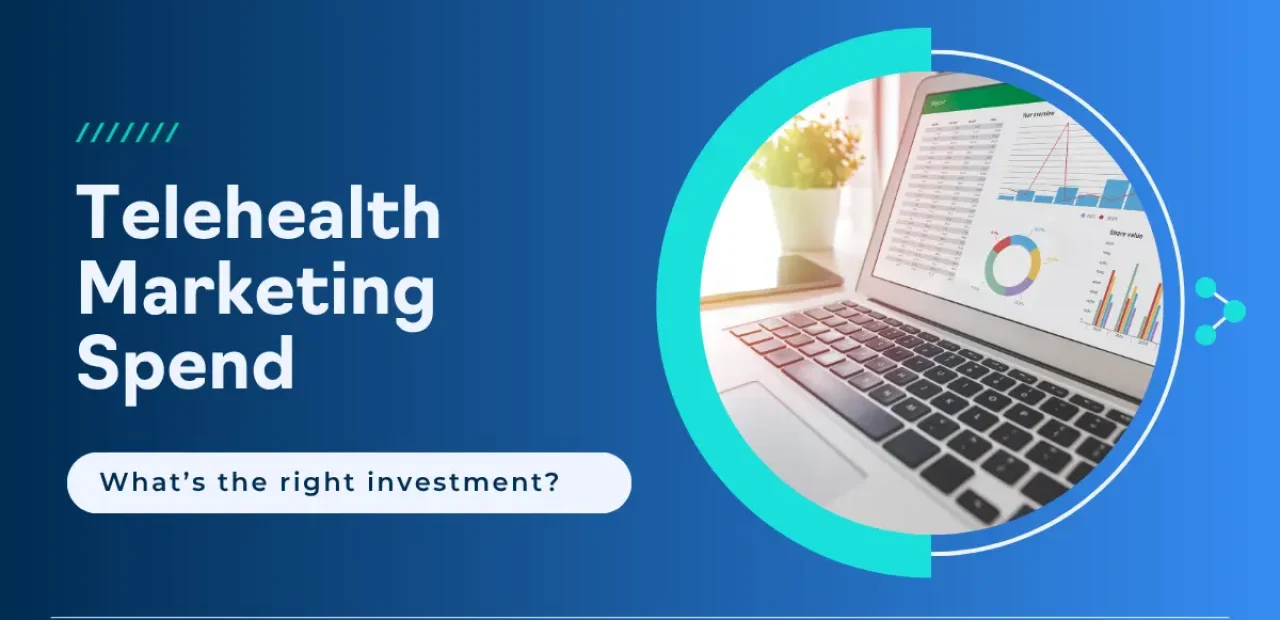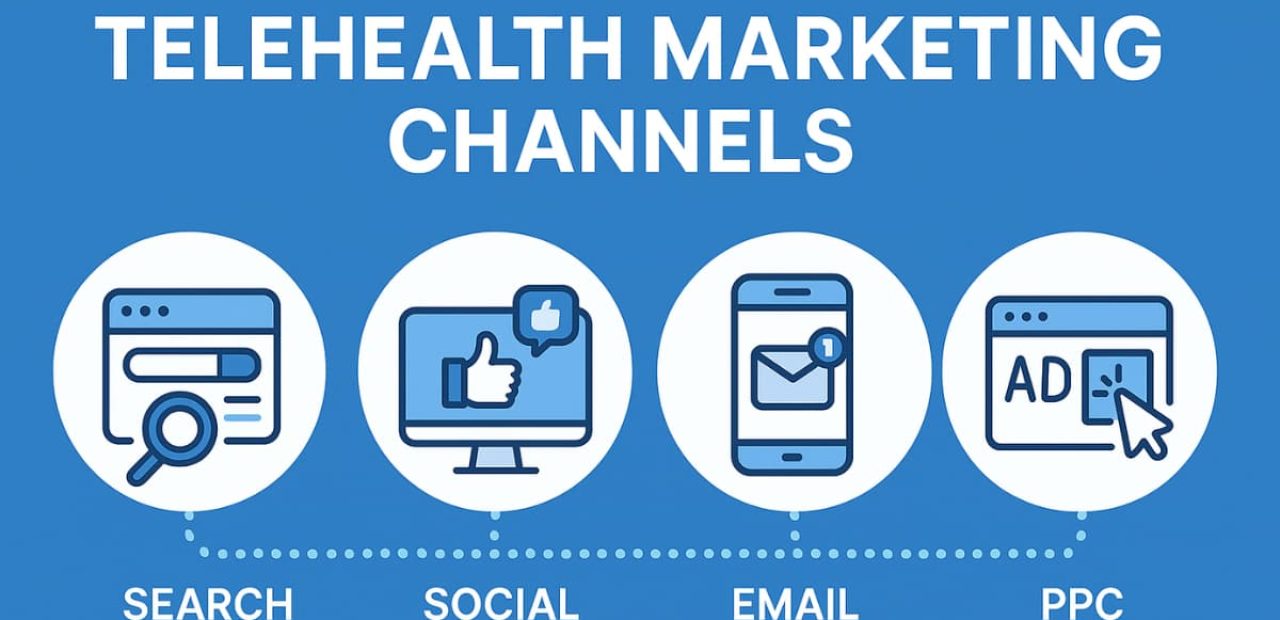What is Telehealth Digital Marketing?
Telehealth digital marketing is the strategic use of online channels and platforms to attract, engage, and convert patients seeking virtual healthcare services. It combines traditional healthcare marketing principles with digital-first strategies like SEO, paid advertising, content marketing, and social media to build trust, demonstrate medical expertise, and drive patient acquisition for telemedicine and remote care providers.
Key Takeaways
- Industry average patient acquisition: $150-300 (Healthcare Finance News, 2024)
- Top channel: Paid search captures 65% of healthcare queries (Google Health Study)
- ROI potential: Optimized campaigns see 3-5x return on ad spend
- Mobile reality: 77% of patients search for providers on smartphones
- Conversion rates: Well-designed telehealth sites convert at 3-5% (vs. 1% average)
- HIPAA compliance: Required for all patient tracking – non-negotiable
Most telehealth providers? They’re bleeding money on marketing that barely moves the needle. Industry studies show the average patient acquisition cost runs $150-300.
Which is nuts.
Here’s the thing – after years in healthcare marketing, I’ve seen what actually works. And what doesn’t. The difference between spending $300 per patient and $67? It’s not magic.
It’s just doing the basics really, really well. (Something most agencies apparently can’t figure out.)
The telehealth boom created massive opportunity. But it also created massive competition. Virtual care visits jumped from 1% to 46% of all medical appointments since 2020. Everyone’s fighting for the same patients online.
Good news? Most providers are doing telehealth digital marketing wrong. Like, spectacularly wrong. They’re treating it like traditional healthcare marketing – and wondering why their phones aren’t ringing.
What Should Your Telehealth Marketing Message Communicate to Patients?

Here’s what drives me crazy: Telehealth companies trying to compete on “convenience.”
Everyone’s convenient. Every virtual care provider lets patients “see a doctor from home.” That’s not a differentiator anymore – it’s table stakes.
So what actually makes patients choose YOU over the 47 other telehealth options in their Google search results?
Start here: Stop talking about your features. Start talking about their Friday night.
The Messaging Framework That Actually Converts
Wrong: “We offer 24/7 virtual consultations with board-certified physicians.”
Right: “Kid woke up with a fever at 2 AM? Get a prescription to your pharmacy by 2:30.”
See the difference? One’s about you. The other’s about them – in that panicked moment when they actually need you.
Here’s what’s working right now:
| Pain Point | Weak Message | Strong Message |
|---|---|---|
| Cost concerns | “Affordable telehealth services” | “Just $49. Less than your insurance copay.” |
| Trust issues | “Licensed healthcare providers” | “See your provider’s medical school, residency, and patient reviews before booking.” |
| Time anxiety | “Quick appointments available” | “Average wait time: 7 minutes. We track it live.” |
| Tech worries | “Easy-to-use platform” | “If you can FaceTime grandma, you can see your doctor.” |
| Privacy fears | “HIPAA-compliant platform” | “Your medical info is safer here than at most hospitals. Here’s exactly how we protect it…” |
Patients don’t care about your telemedicine platform. They care about getting their UTI treated before their big presentation tomorrow.
How to Rank Your Telehealth Website on Google

Alright, let’s talk about the elephant in the room.
Everyone wants to rank #1 for “online doctor.” Good luck with that. You’re competing against Teladoc’s $50 million marketing budget.
But here’s what most people miss: You don’t need to rank for “online doctor.” You need to rank for “UTI treatment online tonight” and “can I get antibiotics through telehealth?”
See the difference? One’s a vanity metric. The other’s a patient with their credit card out.
First, some brutal honesty. Regular SEO rules? They don’t fully apply to healthcare. Google’s YMYL (Your Money or Your Life) algorithm update means medical content gets scrutinized differently.
You can’t just stuff keywords and hope for the best. Google wants to see:
- Medical credentials prominently displayed
- Content reviewed by actual healthcare providers
- Clear authorship with verifiable licenses
- Update dates on all medical information
Miss any of these? You’re invisible.
What Are The Most Important SEO Tips for Telehealth?
Here’s the breakdown of exactly what works. These seven strategies aren’t theoretical, they’re what I’ve seen move the needle for telehealth providers who went from invisible to booked solid. Master these basics before chasing advanced tactics, and you’ll outrank competitors spending 10x more on complicated SEO strategies.
7 Essential SEO Tips for Telehealth
The only tactics that drive 80% of results
1. Answer the Midnight Questions
You know what ranks? Content that sounds like a real doctor talking to a worried patient.
Not this: “Acute bronchitis is an inflammation of the bronchial tubes, typically lasting 10-14 days with symptomatic presentation including…”
This: “That barking cough keeping you up? Here’s when it’s just bronchitis (annoying but harmless) versus when you need to worry. First, check if…”
Create content for these moments:
- “Is this rash serious?” (with actual photos)
- “Can I get a doctor’s note through telehealth?”
- “Threw out my back and can’t drive – help”
- “My anxiety meds ran out and my doctor is closed”
This is what we call “Reverse ER” content – you’re catching patients before they panic and drive to the emergency room. Stop thinking like a hospital. Start thinking like a patient at 10 PM with a screaming kid.
They’re not searching “pediatric telemedicine services.” They’re typing “baby fever won’t go down what do I do.”
2. The Credibility Stack
Google’s medical algorithm update (August 2024) made this non-negotiable. Every page needs:
Medical Reviewer: Dr. Sarah Johnson, MD
Board Certified in Internal Medicine
Harvard Medical School, 2015
[Link to state medical board verification]
Vital Metadata
Last Updated: January 7, 2025
Written by: Licensed medical professional
Fact-checked by: Clinical review team
No credentials = no rankings. It’s that simple now.
3. Build Your “Condition Library” (But Do It Right)
Everyone builds condition pages. Most do it wrong.
Bad: “Diabetes – Types, Symptoms, Treatment”
Good: “Just Diagnosed with Type 2 Diabetes? Your First 30 Days Guide”
See what I did there? Same information. Completely different approach.
Your condition pages should:
- Start with what patients do FIRST (not medical definitions)
- Include “Can telehealth treat this?” sections
- Add cost ranges and insurance info
- Link to your booking system contextually
- Update monthly (Google tracks this)
4. Local SEO for Virtual Care
“But we’re online! We don’t need local SEO!”
Wrong. Dead wrong.
Here’s why: 82% of telehealth searches include location modifiers. “Online doctor near me.” “Telehealth in Florida.” “Virtual therapy NYC.”
Google still wants to know WHERE you can legally practice. Your medical licenses dictate your service areas – and Google knows this.
Quick wins:
- Create location pages for every state you’re licensed in
- Add your virtual practice to Google Business Profile
- Include “serving [location]” in your title tags
- Build citations in medical directories for each state
5. The Mobile Reality Check
77% of health searches happen on phones. Your beautiful desktop site? Irrelevant.
Test this right now: Open your site on your phone. Try to book an appointment with your thumb while holding a coffee.
Can’t do it easily? You’re losing patients.
Fix these first:
- Finger-sized buttons (minimum 44×44 pixels)
- Phone numbers that actually dial when tapped
- Forms that don’t require seventeen fields
- Text that’s readable without zooming
6. Voice Search Optimization
“Hey Google, I need a doctor for my kid’s ear infection.”
That’s not keyword research. That’s how real people search now. 40% of adults use voice search for health questions (Google Health Consumer Survey).
Optimize for conversational queries:
- Use full questions as H2 headers
- Write how people actually talk
- Include location phrases naturally
- Answer immediately (no fluff intros)
7. Site Speed Optimization
Your site takes 4.2 seconds to load? You just lost 53% of mobile visitors. (Google/SOASTA Research, 2017)
Healthcare sites are the worst offenders. Heavy images, bloated patient portals, seventeen tracking scripts…
Here’s the thing: Sick people are impatient people. Your site needs to load in under 2 seconds. Period.
Is Google Ads Worth It for Telehealth Providers?
Short answer? Yes – if you do it right.
Long answer? Most telehealth companies light money on fire with Google Ads because they treat it like a billboard. Set it and forget it.
Here’s the thing: A patient searching “online doctor now” at 11 PM with a sick kid? They’re not comparison shopping. They’re clicking the first credible result.
That could be you. Or your competitor who actually knows what they’re doing.
The Math Nobody Wants to Talk About
Let’s get real about costs. Healthcare keywords are expensive. Like, stupidly expensive.
Average cost-per-click for telehealth keywords:
- “Online doctor”: $8-15
- “Telemedicine urgent care”: $12-20
- “Psychiatrist online”: $15-30
- “Get prescription online”: $20-35
Shocked? Wait, it gets worse.
Your average conversion rate (if you’re lucky): 2-3%.
Do the math. At $15 per click and 2% conversion, you’re paying $750 per patient.
Which is why most providers quit after burning through $10K with nothing to show for it.
How to Not Waste Your Money
Stop Bidding on Ego Keywords
“Telemedicine” gets 100,000 searches. Know what it doesn’t get? Patients.
Someone searching “telemedicine” is probably:
- Writing a school paper
- Researching the industry
- A competitor checking you out
Someone searching “can I get antibiotics online for UTI today” is ready to pay you money. Right now.
Focus your budget on high-intent searches:
- Condition + “treatment online”
- “Prescription for [medication] online”
- “Doctor video call tonight”
- “Urgent care videochat no insurance”
The Geo-Targeting Secret
Plot twist: Even virtual care needs location targeting.
Why? State medical licenses. You can’t treat patients in states where you’re not licensed. Advertising there is literally burning money.
But here’s what most miss – time zone targeting.
California patients searching at 9 PM? Your East Coast doctors are asleep. Unless you have 24/7 coverage, you’re paying for clicks you can’t convert.
Set up your campaigns by:
- State medical licenses
- Provider availability hours
- Time zone coverage
- Excluded locations (states you can’t serve)
The Landing Page Problem
Sending Google Ads traffic to your homepage? That’s like inviting someone to dinner then making them search your house for food.
Every ad needs its own landing page. Period.
- UTI treatment ad? → UTI-specific landing page
- Anxiety medication ad? → Anxiety treatment page
- Pediatric care ad? → Kids’ health landing page
Each page needs:
- Headline matching the ad exactly
- Provider availability RIGHT THERE
- One-click booking (not “create account first”)
- Price transparency
- Trust signals above the fold
What Content Should Telehealth Companies Create?

Let’s be honest about content marketing in healthcare.
Nobody wakes up thinking, “I can’t wait to read a blog post about telemedicine benefits today!”
They wake up with a problem. Your content better solve it.
Forget “thought leadership.” Forget “brand awareness.” Here’s what actually drives bookings:
These are your money pages. Every telehealth provider needs them:
1. The “Can I?” Content Series
- “Can I get a doctor’s note through telehealth?”
- “Can I get antibiotics online for a UTI?”
- “Can I refill my anxiety medication virtually?”
- “Can I get an STD test through telehealth?”
Why these work: They match exactly what worried patients type at midnight.
Each article needs:
- Clear YES or NO answer in first sentence
- State-by-state restrictions (if any)
- Exact process (with screenshots)
- Cost range
- “Book Now” button every 300 words
2. The “What to Expect” Guides
Patients ghost virtual appointments because they’re anxious about the unknown. Kill that anxiety with radical transparency.
Create these:
- “Your First Telehealth Visit: A Minute-by-Minute Guide”
- “What Happens After Your Virtual Doctor Visit”
- “How Online Prescriptions Work (With Real Examples)”
- “Telehealth for Kids: Keeping Your Toddler Still for 15 Minutes”
Include actual screenshots. Show the interface. Film a mock appointment. The more real you make it, the more comfortable patients feel.
3. Condition-Specific Cost Calculators
Price transparency builds trust. But nobody wants to see “$75-$300 depending on complexity.”
Build interactive content:
- “UTI Treatment Cost Calculator” (with/without insurance)
- “Mental Health Therapy Session Estimator”
- “Annual Savings: Telehealth vs. Traditional Care”
Make them actually useful. Not lead-gen forms disguised as tools.
The Video Content Nobody’s Making (But Should)
Text is great. Video converts 3x better.
But please, for the love of all that’s holy, stop making “talking head explains telemedicine” videos.
Make these instead:
“Day in the Life” Provider Videos Show your doctors as humans. Follow them through their day. Let patients see who they’re trusting with their health.
“Behind the Scenes” Tech Tours How does your platform protect privacy? Show the actual security measures. Make HIPAA compliance visual and interesting.
60-Second Condition Explainers “Is it strep throat or just a sore throat?” Quick, visual differentiators. Perfect for social media.
Real Patient Stories (with permission) “How Sarah Manages Her Anxiety with Weekly Virtual Therapy” Nothing builds trust like real stories. Just blur faces and change names.
The FAQ Section That Sells
Your FAQ page is probably boring. And buried.
It should be your highest-converting page. Here’s how:
Structure FAQs by user journey stage:
Considering Telehealth
- “Is virtual care as good as in-person?”
- “What conditions can’t be treated online?”
- “Do I need special equipment?”
Ready to Book
- “How much does a visit cost?”
- “Do you accept my insurance?”
- “What if I need labs or imaging?”
Overcoming Objections
- “What if I need a physical exam?”
- “Can you prescribe controlled substances?”
- “Is my medical information secure?”
Answer honestly. If you can’t prescribe Xanax, say so. Transparency beats disappointed patients.
The Email Strategy Everyone Screws Up
You know what patients don’t want? Weekly newsletters about “advances in telemedicine.”
You know what they do want? Useful health tips they can act on.
Email sequences that work
After first visit:
- Day 1: “How are you feeling?” (check-in)
- Day 3: Medication reminder + side effects to watch
- Day 7: Related health tips (not sales pitches)
- Day 14: Gentle follow-up scheduling reminder
For chronic conditions:
- Weekly management tips
- Medication refill reminders
- Seasonal health alerts
- Provider availability updates
Keep them short. Like, really short. Three paragraphs max.
Your Next Move (Because Reading Won’t Get You Patients)
Alright, real talk.
You just read 2,500+ words about telehealth marketing. You could read 2,000 more. But here’s the thing – your competitors aren’t reading. They’re doing.
While you’re here, they’re stealing 3-5 patients every hour through better digital marketing.
Harsh? Maybe.
True? Absolutely.
The 30-Day Quick Win Plan
Want to see real results fast? Here’s exactly what to do:
Week 1: Stop the Bleeding
- Audit your Google Ads (you’re probably wasting 40% of budget)
- Fix your mobile site speed (under 2 seconds or bust)
- Add clear pricing to your homepage
- Set up call tracking (you can’t improve what you don’t measure)
Week 2: Capture Low-Hanging Fruit
- Create 5 “Can I?” pages for your top conditions
- Launch retargeting campaigns for site visitors
- Fix your Google Business Profile (add virtual care services)
- Test one high-intent PPC campaign
Week 3: Build Momentum
- Add provider videos to condition pages
- Create state-specific landing pages
- Implement FAQ schema markup
- Start email follow-up sequences
Week 4: Scale What Works
- Double down on converting keywords
- Expand to similar conditions
- Add patient testimonials everywhere
- Test new ad copy based on data
Do just these things? You’ll see 20-30% more patients within 30 days. Guaranteed.
But Here’s the Problem…
You know what you need to do. The question is: Will you actually do it?
Because let’s be honest – you got into healthcare to help patients, not to become a digital marketing expert. You’ve got patients to see, staff to manage, and about 47 other things on your plate.
That’s where we come in.
Work With Telehealth Marketing Experts Who Actually Get Results
Look, I could give you another generic pitch about our “proven strategies” and “expert team.”
Instead, I’ll tell you this:
We focus exclusively on healthcare digital marketing because that’s what we actually know. We don’t take on every client that calls, we work with providers who are serious about getting results, not just checking a marketing box.
What you get:
- Complete audit of your current marketing (no charge)
- Honest assessment of your patient acquisition costs
- Realistic plan to reduce your patient acquisition costs within 90 days
- Direct access to senior strategists (not interns)
- Monthly reports you’ll actually understand
What you won’t get:
- 12-month contracts (month-to-month only)
- Vague promises about “brand awareness”
- Excuses about why campaigns aren’t working
- Hidden fees or surprise charges
The Bottom Line
Every day you wait is another day your competitors pull further ahead. Another day of overpaying for patients. Another day of leaving money on the table.
The telehealth gold rush is happening right now. The providers who figure out digital marketing will dominate. The ones who don’t? They’ll be competing on price forever.
Got questions? Let’s talk. 30 minutes with someone who actually knows telehealth marketing (not a sales rep reading a script).
We’ll discuss:
- Your specific challenges
- What’s working in your market
- Realistic budgets and timelines
- Whether we’re even a good fit






